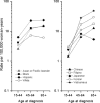Cervical cancer incidence among 6 asian ethnic groups in the United States, 1996 through 2004
- PMID: 20029972
- PMCID: PMC5736370
- DOI: 10.1002/cncr.24843
Cervical cancer incidence among 6 asian ethnic groups in the United States, 1996 through 2004
Abstract
Background: Cervical cancer incidence was evaluated by histologic type, age at diagnosis, and disease stage for 6 Asian ethnic groups residing in the United States.
Methods: Incidence rates were estimated for cervical squamous cell carcinoma (SCC) and adenocarcinoma by age and stage for 6 Asian ethnic groups-Asian Indian/Pakistani, Chinese, Filipino, Japanese, Korean, and Vietnamese-in 5 US cancer registry areas during 1996 through 2004. For comparison, rates among non-Hispanic whites, non-Hispanic blacks, and Hispanics were also calculated.
Results: During 1996 through 2004, Vietnamese women had the highest (18.9 per 100,000) and Asian Indian/Pakistani women had the lowest (4.5) incidence of cervical cancer; this pattern was consistent by histologic type. Vietnamese women also had the highest incidence for localized (7.3) and regional (5.7) SCC and for localized (2.4) adenocarcinoma. Contrary to the plateau of SCC incidence apparent among white women by age 45 years, SCC rates continued to rise with age among Chinese, Filipina, Korean, and Vietnamese women.
Conclusions: There exists large variation in invasive cervical cancer incidence patterns among Asian ethnic groups in the United States and in comparison with rates for blacks, Hispanics, and whites. Early detection and prevention strategies for cervical cancer among Asians require targeted strategies by ethnic group.
Figures


References
-
- Barnholtz-Sloan J, Patel N, Rollison D, et al. Incidence trends of invasive cervical cancer in the United States by combined race and ethnicity. Cancer Causes Control. 2009;20:1129–1138. - PubMed
-
- Wang SS, Sherman ME, Hildesheim A, Lacey JV, Jr, Devesa S. Cervical adenocarcinoma and squamous cell carcinoma incidence trends among white women and black women in the United States for 1976–2000. Cancer. 2004;100:1035–1044. - PubMed
-
- Watson M, Saraiya M, Benard V, et al. Burden of cervical cancer in the United States, 1998–2003. Cancer. 2008;113:2855–2864. - PubMed
-
- McCracken M, Olsen M, Chen MS, Jr, et al. Cancer incidence, mortality, and associated risk factors among Asian Americans of Chinese, Filipino, Vietnamese, Korean, and Japanese ethnicities. CA Cancer J Clin. 2007;57:190–205. - PubMed
Publication types
MeSH terms
Grants and funding
LinkOut - more resources
Full Text Sources
Medical
Research Materials

